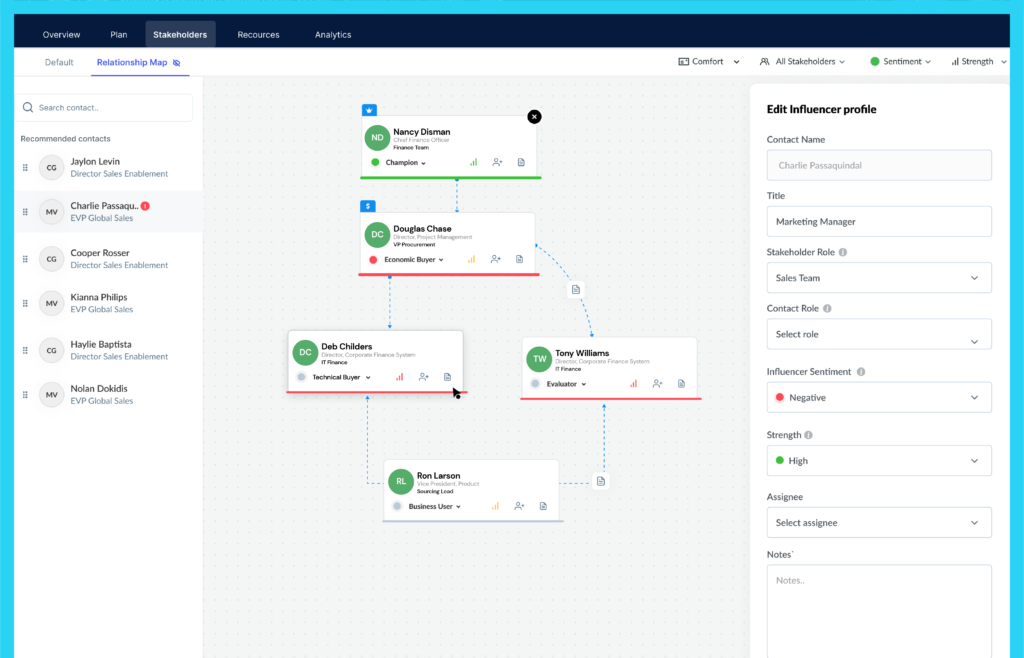 BACK TO BLOG
BACK TO BLOG
Know your Buyers: How Relationship Maps set your Sellers up for Enterprise Sales Success?

 BACK TO BLOG
BACK TO BLOG

In enterprise sales, winning customers is like solving a complex maze involving many buyers and competing priorities.
What might once have been accomplished over a face-to-face workshop or dinner now requires a digital-first approach to a sprawling group of buying stakeholders (many of whom you may never know or meet). Failing to identify these buyers and the lines of influence in connecting them can cause heartburn in the process or loss of the deal altogether.
The single biggest reason deals don't transpire to the stage where you’d like is due to poor forecasts and relationships. And building relationships with buying stakeholders is a more complicated endeavor than it used to be.

The sales team may not have full visibility into all the buyers & the decision-making process inside the organisation. Tools like deal clinics and mutual success plans have become critical in ensuring deals are headed in the right direction with the right momentum.
A relationship map is typically used to identify and visualize the various stakeholders involved in a sales opportunity or a project, and to help salespeople or project managers understand how those stakeholders are related to each other. The map may include information such as the stakeholders' roles and responsibilities, their level of influence, and their relationships with one another.
A relationship map can be a powerful tool in sales because it helps salespeople to better understand the complex web of relationships and decision-making processes within a customer organization. Here are some ways in which a relationship map can be used in sales:
In its simplest form, B2B sales success is identifying a champion(or mobilizer). But if you want to run a well-oiled sales machine, you must ensure your sellers identify all key stakeholders and their roles in the decision-making process, especially for enterprise deals. Without analyzing a visual representation of the relationships with the opportunity, you can’t strategise the people strategy in a deal.

There are three kinds of information about buyer relationships that you would want your sales team to map for every opportunity:
Your sellers are dealing with several buyers distributed across different teams in an organization (Core business team, IT, finance, legal and more) and each of them very specific influence on the deal. And so, one of the most critical tasks for sellers is to identify these buying stakeholders, evaluate their role in each dimension, and create a standout value prop for their pain mapping the collective need.
We often look at MEDDIC (or equivalent qualification frameworks) as a way to identify risks in a deal. But does that give you the full picture, especially in big deals?
Knowing the relationships, individual buyer preferences, and their influence in the buying journey is at the heart of knowing if a deal is real or what needs to be done to win it.

Recommended deal review framework:
Review and progress relationships -> Review the mutual success plan and opportunity scorecard (MEDDIC) -> Document asks and drives progress.
The first step in an effective deal review process involves knowing relationships and diagnosing issues with them. Here is an example of what a relationship map looks like:

Reviewing the influence map, the buyer role, their influence, sentiment and relationship strength can give you an understanding of the current state. Having clarity on asks, multi-threading ownership mapping and next steps will ensure execution activities that can move deals are mapped and tracked.
Your sales efforts may not have guaranteed success unless your sales team truly comprehends what buyers value, how they gather information, and how purchase decisions get made. And to smoothly manage sales cycles with modern buyers, your sales teams need maximum alignment on their activities, plans, and, more importantly, the buyer themselves.
If you are interested in putting together (or updating) a deal review process, read this blog.
Digital selling requires a complete undertaking of relationships. With more stakeholders involved in each step, it will get even more complicated. To win in the decision-by-committee era, companies must understand the current needs, motivations and inter-relational dynamics of all the key players and use that insight to win more deals.
